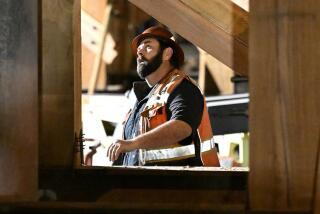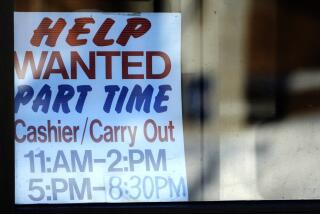Dual Jobs Are Growing Trend as Home Costs Take Bigger Bite
- Share via
NEW YORK — A little-noted report suggests that more Americans are working at two jobs now than at any time in decades, perhaps since the 1940s, when there was a war-induced labor shortage.
The report, from the Labor Department, shows dual jobs to be a growing trend. In 1980, 4.9 % of employed people held two jobs. The percentage rose to 5.4 in 1985. And in 1989, it continued on to 6.2%.
Simultaneously over the past decade, there has been a tendency of women to put in more hours at “official” rather than family jobs and for older workers to supplement pensions by working at retail outlets.
Marriages are occurring later than before, and there is a similar tendency to postpone children until later in life. And to afford a home under present conditions often requires the bounty of two incomes.
Still, in many areas of the country the financing and upkeep of the home take a larger percentage of household income than they used to, up to 50% in certain instances, or double what used to be considered affordable.
Question: Is this really the good life that was promised? Is this progress?
In spite of so-called affluence, for example, debt is increasing. And that same Labor Department survey shows that 44% of those working an extra job are doing so to meet household expenses and to pay debts.
Consider this: While more women than ever are working, well over 50% of them, they earn less than men and advance more slowly. And surveys show they still haven’t shed most of their household chores.
Questions about progress arise in other areas too. The national debt is greater than ever. Productivity increases have slowed. For the first time since the Great Depression of the 1930s, the percentage of homeowners is shrinking.
Success in the fight against poverty has slowed. Herbert Hoover in 1928 said the country was “nearer to the final triumph over poverty than ever before in the history of any land.” Today, one in seven live in “poverty.”
Progress? Consider these facts, taken from a study by the U.S. Census Bureau and the Conference Board, a private, not-for-profit educational and research group:
Since 1900, life expectancy has risen from under 50 years to more than 75. Infant mortality has fallen from 99 per 1,000 births in 1915 to about 11 today. Average weekly hours in manufacturing declined to 40.5 hours in 1985 from 49.4 hours in 1915, while real hourly wages rose from $2.44 to $9.53.
Comparable net worth figures weren’t available for earlier years of the century, but in 1950 per capita net assets were $27,021, half those of 1985. And the relative costs of food, clothing and shelter have declined steadily.
More houses have indoor plumbing and central heating systems. And each year those houses seem to have more baths, swimming pools, decks, family rooms, telephones, radios, TVs, electric toasters, computers and smoke alarms.
Vacation time has risen. Leisure has become a big business, and activities that once were the exclusive preserve of the elite, such as golf, tennis, sailing and skiing, are growth industries.
“More money, more leisure and the pursuit of fun and travel have enormously enriched the way we live,” says the report.
What do you think?
More to Read
Inside the business of entertainment
The Wide Shot brings you news, analysis and insights on everything from streaming wars to production — and what it all means for the future.
You may occasionally receive promotional content from the Los Angeles Times.










